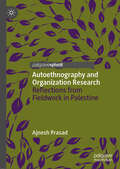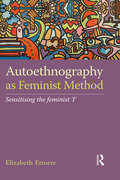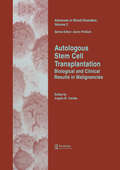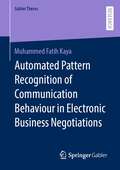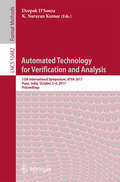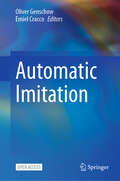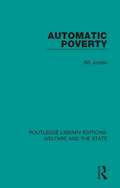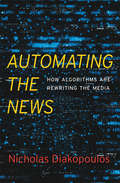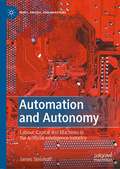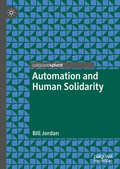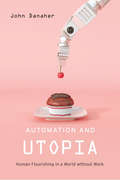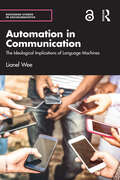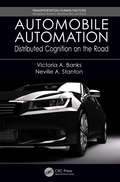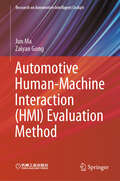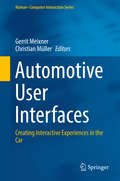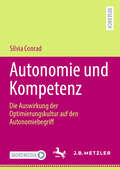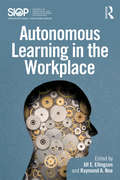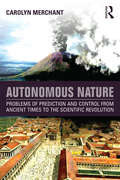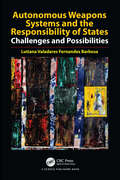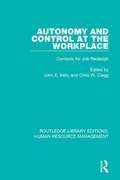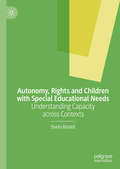- Table View
- List View
Autoethnography and Organization Research: Reflections from Fieldwork in Palestine
by Ajnesh PrasadAs a method for empirical inquiry, autoethnography has gained much purchase among business school academics. This book offers exemplars of how autoethnography can be leveraged to study myriad organization and management phenomena. Drawing on his own fieldwork in Palestine, the author engages with several timely questions including: What are the ethical implications of pursuing organization research at neo-colonial spaces? How should we account for the 'Other' when studying in ideologically fraught sites? And, how should we write so as to capture the spirit of autoethnography? In sum, this seminal text highlights the benefits of autoethnography in business school research.
Autoethnography as Feminist Method: Sensitising the feminist 'I'
by Elizabeth EttorreAutoethnography is an ideal method to study the ‘feminist I’. Through personal stories, the author reflects on how feminists negotiate agency and the effect this has on one's political sensibilities. Speaking about oneself transforms into stories of political responsibility - a key issue for feminists who function as cultural mediators.
Autologous Stem Cell Transplantation: Biological and Clinical Results in Malignancies (Acta Haematologic Ser. #Vol. 114, No. 4)
by Angelo CarellaThis textbook integrates basic research and clinical aspects underlying the most recent results in those malignant diseases where progress is most effective.Recent evidence shows that higher doses are better in inducing higher cure rates in hematological neoplasias, although myeloblation related to dose intensity can be a limiting factor. The toxicity can now be controlled with autologous marrow and peripheral blood progenitor cell transplantation, used with or without growth factors. The combination of high dose chemoradiotherapy followed by re-infusion of autologous stem cells constitute a dramatic advance in the treatment of refactory and relapse hematological neoplasias.
Automated Pattern Recognition of Communication Behaviour in Electronic Business Negotiations (Gabler Theses)
by Muhammed Fatih KayaThe world of digitalisation is changing the way how people and business companies communicate with each other. Electronic negotiations represent one of the most important forms of business communication and can influence the successes and failures of companies in a significant way, whether in interorganisational or intraorganisational processes. Analysing negotiation interactions to determine pattern-based peculiarities in the communication offers new value-adding information concerning the management of optimised communication processes, even though the machine-based processing of communication data bears a series of challenges. The present book develops a new approach to analyse the automated pattern recognition potential of Machine Learning methods in unstructured negotiation communication. It presents holistic research frameworks for the effective detection of structural patterns and reveals the pattern labelling potential in high-dimensional communication data by analytically implementing a series of Machine Learning methods.
Automated Technology for Verification and Analysis: 15th International Symposium, ATVA 2017, Pune, India, October 3–6, 2017, Proceedings (Lecture Notes in Computer Science #10482)
by Deepak D’souza K. Narayan KumarThis book constitutes the refereed proceedings of the 15th International Symposium on Automated Technology for Verification and Analysis, ATVA 2017, held in Pune, India, in October 2017. The 22 full and 7 short papers presented in this volume were carefully reviewed and selected from 78 submissions. The book also contains one invited talk in full-paper length. The contributions are organized in topical sections named: program analysis; model checking and temporal logics; neural networks; learning and invariant synthesis; and hybrid systems and control.
Automatic Imitation
by Oliver Genschow Emiel CraccoPeople spontaneously imitate a wide range of different behaviors. The interest in this phenomenon dates back to at least the 18th century when Adam Smith (1759) argued that imitation can be seen as a primitive form of sympathy. Despite the longstanding interest, it was not until the 20th century that different research fields within psychology and neuroscience started empirically investigating this social phenomenon. This book brings together leading researchers from various domains to provide readers with a recent overview of developments in automatic imitation research. This is an open access book.
Automatic Poverty (Routledge Library Editions: Welfare and the State #9)
by Bill JordanOriginally published in 1981, Automatic Poverty provides a much-needed alternative to the Radical Right’s analysis. The book argues that Britain’s economic decline is symptomatic of an advanced stage of industrialisation in which productive processes are increasingly mechanised, but output remains static. Under these circumstances workers become redundant, the income of the working class diminishes, and dependence on the state increases. The ‘Ricardo phenomenon’ has become long-term feature of the British economy, and the author shows that neither Keynesian nor monetarist policies can remedy its consequences. It reflects a critical stage in the development of capitalism.
Automating Inequality: How High-Tech Tools Profile, Police, and Punish the Poor
by Virginia Eubanks<p>The State of Indiana denies one million applications for healthcare, foodstamps and cash benefits in three years—because a new computer system interprets any mistake as “failure to cooperate.” In Los Angeles, an algorithm calculates the comparative vulnerability of tens of thousands of homeless people in order to prioritize them for an inadequate pool of housing resources. In Pittsburgh, a child welfare agency uses a statistical model to try to predict which children might be future victims of abuse or neglect. <p>Since the dawn of the digital age, decision-making in finance, employment, politics, health and human services has undergone revolutionary change. Today, automated systems—rather than humans—control which neighborhoods get policed, which families attain needed resources, and who is investigated for fraud. While we all live under this new regime of data, the most invasive and punitive systems are aimed at the poor. <p>In Automating Inequality, Virginia Eubanks systematically investigates the impacts of data mining, policy algorithms, and predictive risk models on poor and working-class people in America. The book is full of heart-wrenching and eye-opening stories, from a woman in Indiana whose benefits are literally cut off as she lays dying to a family in Pennsylvania in daily fear of losing their daughter because they fit a certain statistical profile. <p>The U.S. has always used its most cutting-edge science and technology to contain, investigate, discipline and punish the destitute. Like the county poorhouse and scientific charity before them, digital tracking and automated decision-making hide poverty from the middle-class public and give the nation the ethical distance it needs to make inhumane choices: which families get food and which starve, who has housing and who remains homeless, and which families are broken up by the state. In the process, they weaken democracy and betray our most cherished national values. <p>This deeply researched and passionate book could not be more timely.</p>
Automating the News: How Algorithms Are Rewriting the Media
by Nicholas DiakopoulosFrom hidden connections in big data to bots spreading fake news, journalism is increasingly computer-generated. Nicholas Diakopoulos explains the present and future of a world in which algorithms have changed how the news is created, disseminated, and received, and he shows why journalists—and their values—are at little risk of being replaced.
Automation and Autonomy: Labour, Capital and Machines in the Artificial Intelligence Industry (Marx, Engels, and Marxisms)
by James SteinhoffThis book argues that Marxist theory is essential for understanding the contemporary industrialization of the form of artificial intelligence (AI) called machine learning. It includes a political economic history of AI, tracking how it went from a fringe research interest for a handful of scientists in the 1950s to a centerpiece of cybernetic capital fifty years later. It also includes a political economic study of the scale, scope and dynamics of the contemporary AI industry as well as a labour process analysis of commercial machine learning software production, based on interviews with workers and management in AI companies around the world, ranging from tiny startups to giant technology firms. On the basis of this study, Steinhoff develops a Marxist analysis to argue that the popular theory of immaterial labour, which holds that information technologies increase the autonomy of workers from capital, tending towards a post-capitalist economy, does not adequately describe the situation of high-tech digital labour today. In the AI industry, digital labour remains firmly under the control of capital. Steinhoff argues that theories discerning therein an emergent autonomy of labour are in fact witnessing labour’s increasing automation.
Automation and Human Solidarity
by Bill JordanThis book provides a detailed analysis of the economic and political implications of the introduction of Artificial Intelligence and Robotics into the service sector of economies that have so far relied on service jobs to sustain levels of employment. It examines how reliance on coercive measures for enforcing low-paid service work attempts to postpone this third Industrial Revolution, and analyses the struggles that must still take place if we are to achieve a future of freedom and social justice for all. While automation and globalisation have made human solidarities of traditional kinds more difficult to sustain, they have also made new kinds possible. Experiments in social policy, and especially the pilot projects with unconditional Universal Basic Incomes, offer a possible model for a new kind of society. The author argues that it is politics which will determine whether we can achieve these new human solidarities.
Automation and Utopia: Human Flourishing in a World without Work
by John DanaherAutomating technologies threaten to usher in a workless future, but John Danaher argues that this can be a good thing. A world without work may be a kind of utopia, free of the misery of the job and full of opportunities for creativity and exploration. If we play our cards right, automation could be the path to idealized forms of human flourishing.
Automation in Communication: The Ideological Implications of Language Machines (Routledge Studies in Sociolinguistics)
by Lionel WeeBy drawing on multiple examples from healthcare, religion, service encounters and poetry, Lionel Wee presents rich insights into the use of automation in communication through a posthumanist lens. As communication becomes increasingly automated, the use of automation creates significant conceptual challenges for ideologies about language, beliefs about the nature of language, as well as assumptions about the roles that interpretation, anthropomorphism, and folk theories of mind play when language is used in communication. This book unravels the ideological implications of automation in communication and provides a new theoretical ground to address the major issues raised by automation. Wee discusses the importance of thinking carefully about how we identify and distinguish the roles of speaker and hearer. He also argues that we re-evaluate our understanding of the relationship between language and community.This book will be vital to students interested in studying the intersections of AI, language and communication, as well as researchers working in communication studies, linguistics and the broader sociology of language in the age of technological change.
Automobile Automation: Distributed Cognition on the Road (Transportation Human Factors)
by Neville A. Stanton Victoria A. BanksIncreasing levels of driving automation has changed the role of the driver from active operator to passive monitor. However, Systems Design has been plagued by criticism for failing to acknowledge the new role of the driver within the system network. To understand the driver's new role within an automated driving system, the theory of Distributed Cognition is adopted. This approach provides a useful framework for the investigation of allocation of function between multiple agents in the driving system. A Systems Design Framework has been developed that outlines how the Distributed Cognition paradigm can be applied to driving using both qualitative and quantitative research methodologies.
Automotive Human-Machine Interaction (Research on Automotive Intelligent Cockpit)
by Jun Ma Zaiyan GongThis book focuses on the evaluation methodology for automotive human-machine interaction (HMI), which aim to reduce driving distractions, lower operational loads, optimize user experience design, and enhance user value.The book is divided into three parts. The first part, consisting of Chapters 1–3, introduces the evolution of automotive HMI and proposes a three-dimensional orthogonal evaluation system for automotive HMI that is comprehensive, systematic, and quantifiable. This evaluation system incorporates all evaluation items into a spatial matrix consisting of three dimensions: interaction tasks, interaction modalities, and evaluation indexes. The second part provides a comprehensive presentation and in-depth discussion of the evaluation indexes. The three rational evaluation indexes are utility, safety, and efficiency, which can be tested by the real-car driving simulator. The four emotional evaluation indexes are cognition, intelligence, value, and aesthetics. In orderto standardize the latter two subjective indexes, this book summarizes common differences in value between Chinese and European users and organizes typical aesthetic orientations in automotive UI based on art history research. The third part introduces the application of this HMI evaluation system in the automotive R&D process, including how to integrate the evaluation into a real product development process to achieve efficient product iteration.This book is suitable for intelligent cockpit and HMI designers, engineers, and researchers. It is also used as a reference for product managers and students in the field of intelligent connected vehicles.
Automotive User Interfaces: Creating Interactive Experiences in the Car (Human–Computer Interaction Series)
by Christian Müller Gerrit MeixnerThis book focuses on automotive user interfaces for in-vehicle usage, looking at car electronics and its software of hidden technologies (e. g. , ASP, ESP), comfort functions (e. g. , navigation, communication, entertainment) and driver assistance (e. g. , distance checking). The increased complexity of automotive user interfaces, driven by the need for using consumer electronic devices in cars as well as autonomous driving, has sparked a plethora of new research within this field of study. Covering a broad spectrum of detailed topics, the authors of this edited volume offers an outstanding overview of the current state of the art; providing deep insights into usability and user experience, interaction techniques and technologies as well as methods, tools and its applications; exploring the increasing importance of Human-Computer-Interaction (HCI) within the automotive industry. Automotive User Interfaces is intended as an authoritative and valuable resource for professional practitioners and researchers alike, as well as computer science and engineering students who are interested in automotive interfaces.
Autonomie der Kunst?: Zur Aktualität eines gesellschaftlichen Leitbildes (Kunst und Gesellschaft)
by Uta Karstein Nina Tessa ZahnerDer Band diskutiert in interdisziplinärer Breite die Frage, inwiefern Kunst autonom oder von ihren jeweiligen Kontexten abhängig ist.
Autonomie und Kompetenz: Die Auswirkung der Optimierungskultur auf den Autonomiebegriff
by Silvia ConradIm Zentrum des Buches stehen der Begriff der Autonomie und seine Bedeutung (Veränderung und/oder Verlust an Bedeutung) innerhalb der gegenwärtigen Bildungslandschaft. Die zunehmende Relevanz der empirischen Bildungsforschung, Schwerpunktlegung auf die Evaluierung sowie das Aufkommen der Kompetenzmodelle wirkten sich auf die Praxis und Ziele des Bildungsprozesses aus. Die Ursachen und Begleitumstände dieser Veränderung, z. B. die Einführung der Bildungsstandards und weitreichende Testpraxis, werden analysiert und einer Kritik unterzogen.
Autonomous Learning in the Workplace (SIOP Organizational Frontiers Series)
by Jill E. Ellingson Raymond A. NoeTraditionally, organizations and researchers have focused on learning that occurs through formal training and development programs. However, the realities of today’s workplace suggest that it is difficult, if not impossible, for organizations to rely mainly on formal programs for developing human capital. This volume offers a broad-based treatment of autonomous learning to advance our understanding of learner-driven approaches and how organizations can support them. Contributors in industrial/organizational psychology, management, education, and entrepreneurship bring theoretical perspectives to help us understand autonomous learning and its consequences for individuals and organizations. Chapters consider informal learning, self-directed learning, learning from job challenges, mentoring, Massive Open Online Courses (MOOCs), organizational communities of practice, self-regulation, the role of feedback and errors, and how to capture value from autonomous learning. This book will appeal to scholars, researchers, and practitioners in psychology, management, training and development, and educational psychology.
Autonomous Motherhood?
by Susan B. Boyd Fiona Kelly Dorothy E. Chunn Wanda WiegersSince the end of the Second World War, increasing numbers of women have decided to become mothers without intending the biological father or a partner to participate in parenting. Many conceive via donor insemination or adopt; others become pregnant after a brief sexual relationship and decide to parent alone.Using a feminist socio-legal framework, Autonomous Motherhood? probes fundamental assumptions within the law about the nature of family and parenting. Drawing on a range of empirical evidence, including legislative history, case studies, and interviews with single mothers, the authors conclude that while women may now have the economic and social freedom to parent alone, they must still negotiate a socio-legal framework that suggests their choice goes against the interests of society, fatherhood, and children.
Autonomous Nature: Problems of Prediction and Control From Ancient Times to the Scientific Revolution
by Carolyn MerchantAutonomous Nature investigates the history of nature as an active, often unruly force in tension with nature as a rational, logical order from ancient times to the Scientific Revolution of the seventeenth century. Along with subsequent advances in mechanics, hydrodynamics, thermodynamics, and electromagnetism, nature came to be perceived as an orderly, rational, physical world that could be engineered, controlled, and managed. Autonomous Nature focuses on the history of unpredictability, why it was a problem for the ancient world through the Scientific Revolution, and why it is a problem for today. The work is set in the context of vignettes about unpredictable events such as the eruption of Mt. Vesuvius, the Bubonic Plague, the Lisbon Earthquake, and efforts to understand and predict the weather and natural disasters. This book is an ideal text for courses on the environment, environmental history, history of science, or the philosophy of science.
Autonomous Weapons Systems and the Responsibility of States: Challenges and Possibilities
by Lutiana Valadares Fernandes BarbosaThis book reviews whether the existing framework in place can effectively address breaches in the context of Autonomous Weapons Systems (AWS). The work endeavors to map out the main gaps and some possible approaches to address them. Part I sets the ground. First, it provides a concept of AWS. Next, it discusses the accountability gap AWS generate and shows how the international community has put far more emphasis on individual responsibility rather than state responsibility. Part II analyzes the challenges AWS pose to the regime governing state responsibility under international law, as codified in the Draft Articles on State Responsibility (ARSIWA). In this regard, it discusses attribution, breach of an international obligation, tempus comissi delicti, multiple states involved in a breach, force majeure, assurance of non-repetition, issues related to damage, the human-machine interaction and its impacts on state´s responsibility, responsibility for not using AWS, weapons review and the duty of due diligence. Part III summarizes the challenges discussed in part II in thirteen issues of concern and presents possible paths de lege ferenda to address each of those issues, mainly a paradigm shift in attribution and strict liability, among seven other more specific proposals. The conclusion reached is that the current regime on the international responsibility of states is insufficient to deal with the new challenges AWS pose. De lege ferenda, the book argues for following the paths suggested in part III. It also reflects on parts II and III's findings and how many of AWS's challenges to state´s responsibility apply to other autonomous devices. Therefore, through the case study of AWS, this work also opens the broader discussion of the gaps in the international responsibility of states regarding autonomous device misdoings.
Autonomy and Control at the Workplace: Contexts for Job Redesign (Routledge Library Editions: Human Resource Management)
by John E. KellyThis book, first published in 1982, aims to re-examine the phenomenon of job redesign in a series of different but related contexts by including accounts, often using case study material, from people trained in a range of social science disciplines utilising different frames of reference. Thus job redesign is considered in relation to social policy, payment systems, collecting bargaining arrangements and trade unions, new technology, the process of change, organisational structures and functions, information and control systems, and the whole issue of emancipation at work. This title will be of interest to students of business studies and human resource management.
Autonomy, Rights and Children with Special Educational Needs: Understanding Capacity across Contexts
by Sheila RiddellThis books examines the increased prominence of children’s rights in education to ask whether we are witnessing a paradigm shift within the education system. The author uses a wide range of case studies from Scotland and England to examine the extent to which children and young people with Special Educational Needs/ Additional Support Needs are in practice able to realise their new rights of participation and redress. In addition, the book examines the ways in which the child’s capacity to make independent decisions is understood and acted upon in different contexts, and the factors which ultimately promote or inhibit the rights of young people and children with SEN/ ASN. The author asks whether, in a context of tight budgets and often limited support, this new emphasis on children's rights can be seen as ‘window-dressing’ and a distraction from reductions in support for social welfare.
Autopornography: A Memoir of Life in the Lust Lane
by Scott O' HaraIn this provocative book, retired porn star Scott O’Hara (known as “Spunk” by many of his fans from an early punk photospread) gives a backstage look at the world of pornography, revealing why he loved it, what he got out of it, and why he left it. In an autobiographical style, he considers and poses answers to some fascinating questions: What is sex? What makes a porn star? And why does pornography really upset people? You’ll really get to know this noted gay porn star as you get a firsthand look at his life experiences and sexual journeys from his boyhood days of locker room fantasies and sexual experimentation to his years as a porn star and then to his experiences as an individual facing the realities of being HIV-positive. As O’Hara puts it in his Introduction: “This book was written as a last-ditch effort: a way to open up all my closets, let you in on all the dark corners of my life, and give you a better picture of what goes into the making of a porn star. Because if there’s one profession that arouses people’s curiosity, it’s that one.” As you read through the pages of Autopornography, you’ll see how O’Hara’s personality reflects his sexuality, that is, how they have melded into one. His vivid descriptions of personal relationships (with family, friends, lovers, and casual acquaintances) and his many sexual encounters as he traveled the world reveal his love of sex and his desire to live without inhibitions, secrets, or sexual constraints. Reading Autopornography may cause you to reexamine your own sexual boundaries, realize new sexual potential, and discover sexual desires not previously aroused.Listed #14 on Books Bought Mainly by Men 1997 Top 100 Bestsellers as rated by A Different Light Bookstore!
